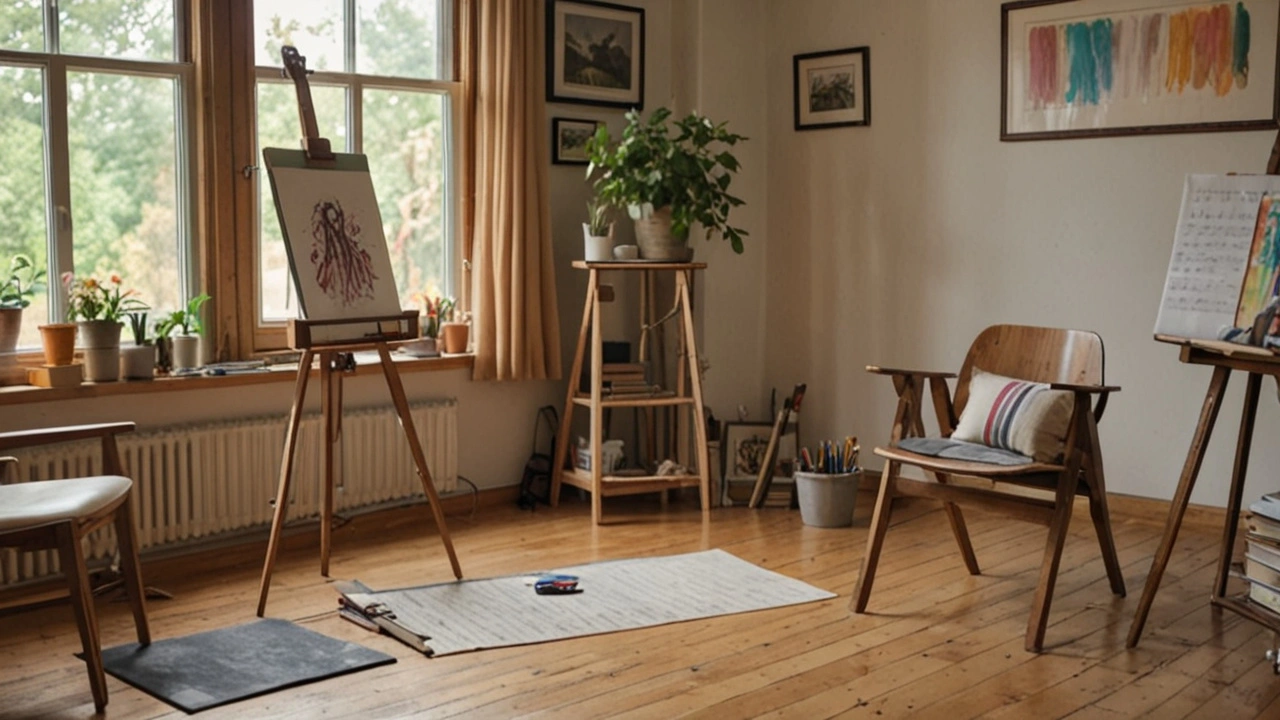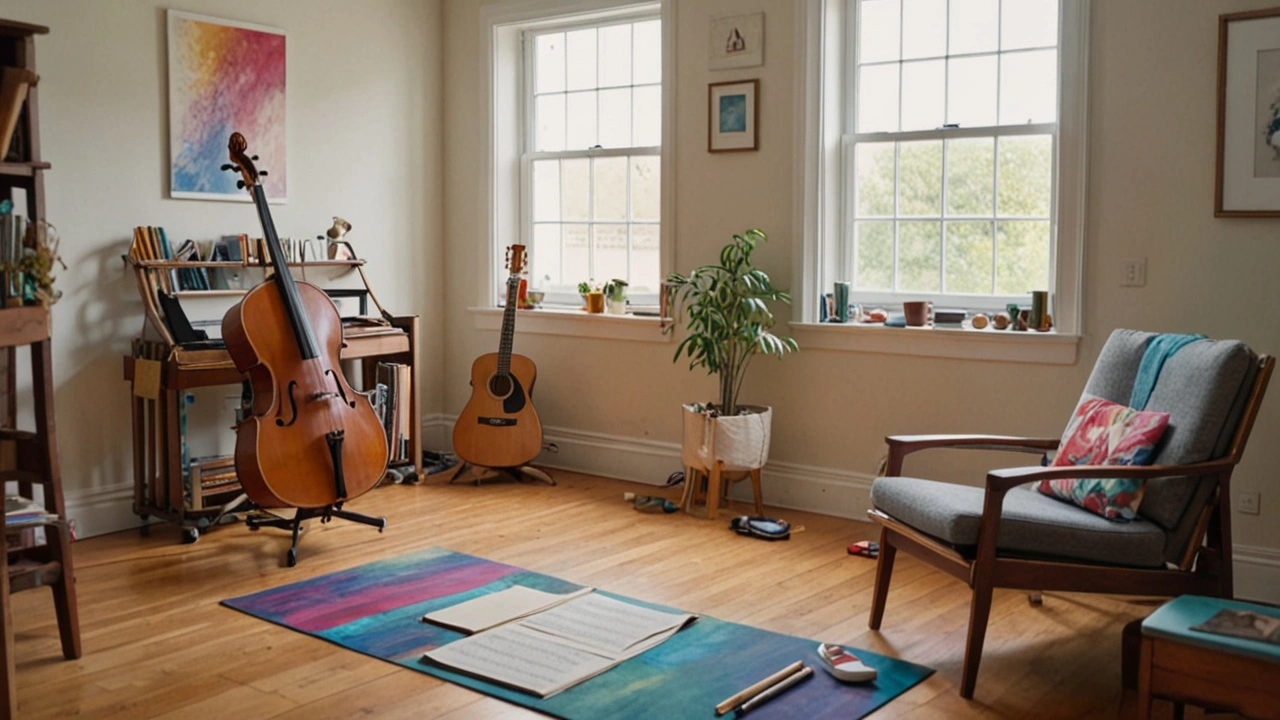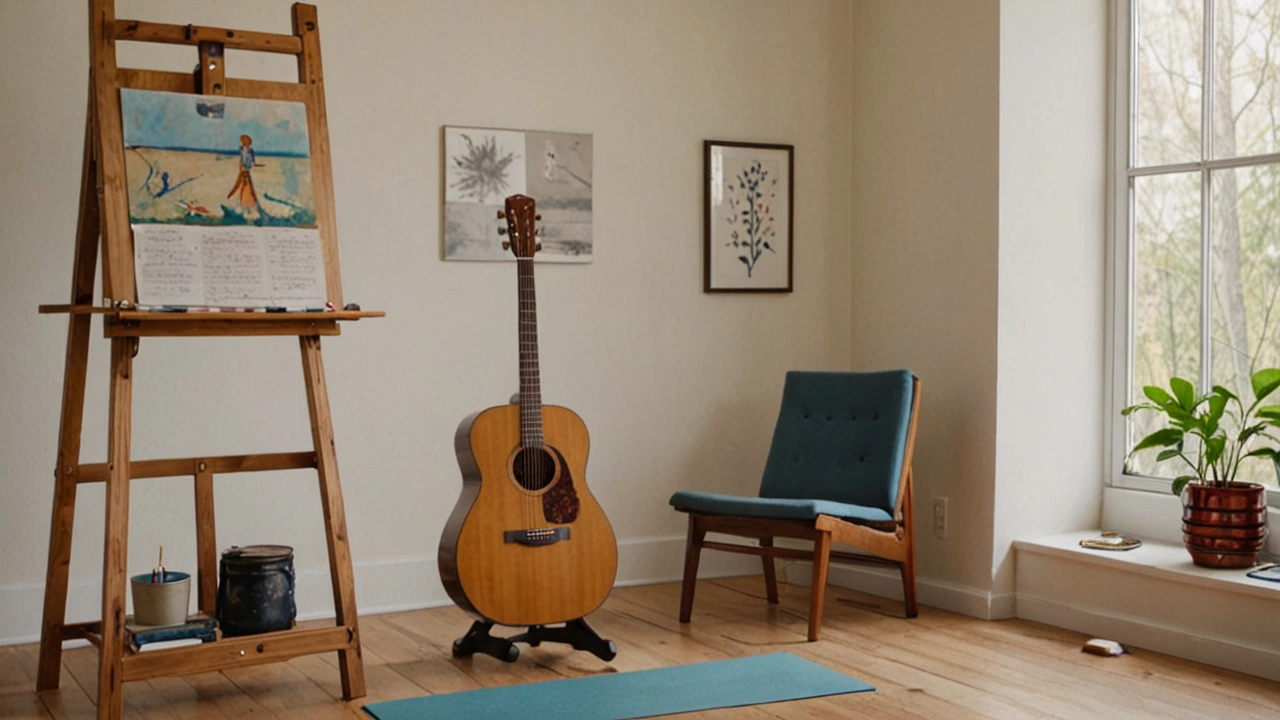
Your wellness routine is more than just physical health; it encompasses mental and emotional well-being too. One powerful way to nurture your mind and spirit is by integrating creative arts therapies into your daily life.
From painting and drawing to music and dance, these forms of creative expression offer unique ways to relax, express emotions, and engage in mindfulness practices. Not only do they help in stress relief, but they also provide a medium to explore and understand one's inner world better.
Let’s dive into how various creative arts therapies can transform your wellness routine and discover practical tips to get started.
- Understanding Creative Arts Therapies
- Benefits of Art Therapy
- Music as a Healing Tool
- Dance and Movement Therapy
- Writing for Wellness
- How to Begin
Understanding Creative Arts Therapies
Creative arts therapies encompass a variety of therapeutic approaches that use artistic activities to address mental health, emotional, and physical challenges. Unlike traditional talk therapies, creative arts therapies engage your creative process, allowing you to express those inner thoughts and emotions through different art forms like painting, music, dance, and writing. This form of therapy is grounded in the belief that creative expression can foster healing and mental well-being.
According to the American Art Therapy Association, art therapy engages the mind, body, and spirit in ways that are distinct from verbal articulation alone. Individuals often find it easier to explore personal issues and express complex feelings through symbolic representations found in art rather than words. This makes art therapy a valuable tool for those who struggle with verbal expression or have experienced trauma.
“Art therapy provides a medium where patients can express emotions that they might not be able to outside the therapeutic space,” says Dr. Thomas Margo, a well-known psychologist specializing in art therapy.
Music therapy is another widely recognized form of creative arts therapy. Using music's inherent ability to affect emotions and moods, this therapy helps people address emotional and mental health issues. Research has shown that music therapy can reduce anxiety, improve mood, and promote a sense of well-being. Music therapists work with clients to create, listen to, or move to music in a way that helps them reach therapeutic goals.
Dance and movement therapy uses the body's movements as a vehicle for expression and healing. This type of therapy is particularly effective for those dealing with issues such as body image, trauma, and social anxiety. The idea is that movement can help release deep-seated emotions and foster a better mind-body connection.
Writing and poetry therapy allows individuals to explore their thoughts and feelings through written words. It provides an outlet for expressing emotions that might be difficult to verbalize. Journaling, structured writing exercises, and poetry composition are all powerful methods for self-discovery and emotional release.
A study published in the Journal of Applied Arts & Health reported that various forms of creative arts therapies significantly improved mental well-being among participants. The research demonstrated reductions in stress, anxiety, and depressive symptoms.
| Form of Therapy | Common Uses |
|---|---|
| Art Therapy | Trauma, emotional expression, self-exploration |
| Music Therapy | Anxiety reduction, mood improvement, emotional release |
| Dance Therapy | Body image issues, trauma, social anxiety |
| Writing Therapy | Self-discovery, emotional expression, trauma |
Incorporating creative arts therapies into your daily wellness routine can offer numerous benefits. These therapies provide a unique outlet for emotions, promote relaxation, and foster mindfulness. By integrating even small doses of artistic activities into your day, you can enhance your mental and emotional health.
Benefits of Art Therapy
Art therapy is a unique blend of creativity and psychotherapy that offers a wide range of benefits for mental and emotional well-being. One of the main advantages is its ability to provide a safe and non-judgmental space for individuals to express their emotions and thoughts visually. This can be significant for those who struggle to articulate their feelings verbally.
Creating art can serve as a powerful way to alleviate stress and anxiety. Engaging in activities like painting, drawing, or sculpting allows individuals to immerse themselves in the creative process, which can be deeply calming and therapeutic. Studies have shown that participating in art-making can decrease cortisol, the body's stress hormone, leading to improved relaxation and reduced anxiety levels.
Art therapy is also known to enhance self-awareness and self-esteem. By working on art projects, individuals can explore different aspects of themselves, identify personal strengths, and recognize inner resources they might not have been aware of. This boost in self-awareness often translates to increased confidence and a more positive self-image.
Moreover, art therapy can help individuals with trauma recovery. It provides a way to process traumatic experiences in a non-verbal manner, making it accessible to those who find it difficult to discuss their trauma. The sensory experience of creating art can help ground individuals in the present moment, which is particularly beneficial for those experiencing flashbacks or intrusive thoughts.
Another benefit of art therapy is its potential to improve cognitive function. Engaging in creative activities stimulates the brain and can improve problem-solving skills, enhance memory, and boost overall cognitive function. This makes art therapy particularly useful for individuals dealing with neurocognitive disorders, such as dementia or Alzheimer's disease.
“Art therapy is about much more than making art. It’s about the process of healing, expressing, and growing,” says renowned art therapist Cathy Malchiodi.For children, art therapy can be a valuable tool in emotional and social development. It helps kids communicate feelings they may not yet have the words to express and can assist in the development of social skills. Art activities can be particularly helpful in encouraging creativity and imagination as part of their growth.
Art therapy is often used to enhance emotional resilience. It provides individuals with an outlet to process their experiences and develop coping strategies for dealing with life's challenges. As individuals create and reflect on their art, they learn new ways to approach problems and adjust to new situations, fostering emotional strength and adaptability.
Additionally, the social aspect of art therapy should not be overlooked. Participating in group art therapy sessions can foster a sense of community and belonging. Sharing the creative process with others can enhance social connections and provide support, helping to reduce feelings of isolation and loneliness.

Music as a Healing Tool
Music has always been a universal language, connecting people across cultures and generations. Its healing powers are well-documented, as it can influence our mood, bring back memories, and even aid in physical healing. One clear example is how patients in hospitals often listen to calming music to reduce anxiety and pain during procedures. Scientific studies show that listening to music can release dopamine, known as the 'feel-good' neurotransmitter, which helps reduce stress and elevate mood.
Incorporating music therapy into your wellness routine can be simple yet effective. Consider setting aside a few minutes each day to listen to your favorite tunes. Choose music that makes you feel relaxed and happy. It might be classical, jazz, or even nature sounds. The key is consistency and allowing yourself to be fully present in the moment. You might even notice that certain types of music help you focus better while working or studying. This can improve your productivity and overall mental clarity.
Active participation in music, such as playing an instrument or singing, can also be profoundly therapeutic. It doesn't matter if you're not a professional musician. Simply playing a few chords on the guitar or humming your favorite song can have a calming effect. Group activities such as joining a choir or a drumming circle offer an additional element of social connection, which is another critical aspect of mental well-being.
It's fascinating how different genres of music can have varied effects. For instance, upbeat and fast-paced genres like pop or dance music can energize you and lift your spirits. On the other hand, slower, more meditative music such as classical or certain types of world music can help with relaxation and mindfulness. Studies have shown that listening to classical music can even enhance cognitive functions and memory, often referred to as the 'Mozart effect.'
"Music expresses that which cannot be said and on which it is impossible to be silent." - Victor Hugo
Consider making a list of your favorite songs or creating playlists for specific purposes. A 'morning motivation' playlist can help kickstart your day, while a 'relaxation' playlist can help you wind down in the evening. Exploring different types of music from various cultures can also open up a new realm of experiences and bring a sense of novelty and excitement to your routine.
Beyond listening, music therapy sessions led by certified therapists offer structured ways to harness the therapeutic benefits of music. These sessions can involve activities like improvisation, songwriting, and listening exercises tailored to your emotional and mental needs. Music therapy is particularly beneficial for individuals with conditions such as depression, PTSD, and neurological disorders.
There is also a growing field called 'sound therapy,' which uses specific frequencies and sound waves to promote healing and well-being. Practices such as sound baths, where you immerse yourself in a room filled with resonate sounds from instruments like crystal bowls and gongs, aim to balance the body's energy and promote deep relaxation. While scientific studies on sound therapy are still in their early stages, many people report feeling more relaxed and rejuvenated after such sessions.
Incorporating music as a healing tool into your wellness routine is not just about improvement but also about enjoyment. It’s a delightful way to nurture your emotional and mental health, making your wellness journey a more enriching experience.
Dance and Movement Therapy
Dance and Movement Therapy is an expressive therapy technique rooted in the idea that the body and mind are interconnected. By using dance and movement, individuals can not only improve their physical fitness but also address emotional and psychological issues. This form of therapy is beneficial for people of all ages and abilities, making it an inclusive option for wellness.
The primary aim of Dance and Movement Therapy is to integrate the physical, emotional, and cognitive aspects of a person. It's not just about the movements but how these movements can express inner feelings and thoughts. This therapy can boost self-esteem, improve body image, and even help in the management of chronic pain by promoting body awareness and emotional release.
Research has shown that dancing can reduce levels of the stress hormone cortisol. For instance, a study published in the American Journal of Dance Therapy found that participants who engaged in regular dance activities reported significantly reduced stress and anxiety levels compared to those who did not. This is because dance offers a creative outlet for expressing suppressed emotions and a safe environment for emotional exploration.
“Dance is the hidden language of the soul,” as famously stated by Martha Graham, the pioneer of modern dance. This sentiment perfectly captures the essence of Dance and Movement Therapy, where the focus is on the emotional and psychological benefits rather than just the physical aspect.
One powerful aspect of Dance and Movement Therapy is that it can be adapted to suit individual needs. Whether it’s a structured dance class or an open movement session where participants move as they wish, the flexibility of this therapy makes it accessible for many. Specific movements or dances can be tailored to address particular issues, whether it’s working through trauma, managing anxiety, or coping with depression.
Incorporating dance into your daily routine doesn’t necessarily mean signing up for a formal class. Even something as simple as putting on your favorite music and allowing your body to move freely in your living room can have a significant impact. The key is in the freedom of expression and the connection between your movements and your inner feelings. The act of dancing itself can be a form of meditation, helping you to stay present and mindful.
If you’re wondering how to start, consider these simple steps:
- Select music that resonates with your current mood. Sometimes, upbeat music can elevate your spirits, while slower melodies might help you process deeper emotions.
- Create a safe space where you can move without restrictions. This might be a spacious room at home or even a secluded spot in a park.
- Allow yourself to move freely without judgment. It’s not about getting the steps right but about what feels right for you in that moment.
- Consider joining local dance or movement groups where you can share the experience with others. Sometimes, just being in a community setting adds another layer of emotional support.
In essence, Dance and Movement Therapy is a holistic approach to wellness that nurtures both the mind and body. So, why not take a step, literally and metaphorically, to explore this expressive form of therapy in your wellness routine?

Writing for Wellness
Writing has been a trusted companion for centuries, offering a safe haven for thoughts, emotions, and creativity. Its magic lies in its simplicity and versatility. Whether you're a seasoned writer or a novice, putting pen to paper (or fingers to keyboard) can significantly enhance your mental and emotional well-being.
Engaging in regular writing can serve multiple purposes. It can act as a tool for reflection, providing clarity and insight into your thoughts and feelings. It's also a skillful way to process complex emotions and experiences, making them more manageable. Many mental health professionals advocate for journaling as a part of therapy because it encourages self-awareness and emotional expression.
A notable approach within writing therapy is expressive writing. This involves writing about your deepest thoughts and feelings related to stress, trauma, or emotional upheaval. Research has shown that expressive writing can lead to better physical and mental health. According to Dr. James Pennebaker, a leading researcher in the field, "writing about emotional experiences can significantly improve health." This therapeutic practice has been linked to improved immune function, reduced blood pressure, and better mood regulation.
Another beneficial writing practice is gratitude journaling. By regularly jotting down things you're thankful for, you invite more positive feelings into your daily life. This doesn’t just help in combating negative emotions but also fosters a greater sense of well-being and satisfaction. Studies have found that people who maintain a gratitude journal are generally happier and have lower levels of stress.
Writing about emotional experiences can significantly improve health. - Dr. James Pennebaker
If you're wondering how to start, here are a few tips. Dedicate a specific time each day to write, even if it’s just for 10 minutes. This could be in the morning to set a positive tone for the day or in the evening to reflect on your experiences. Choose a comfortable and quiet space where you feel relaxed. Don’t worry about grammar, spelling, or style; the focus is on the process, not the product.
Consider different types of writing exercises that suit your needs. You might try free writing, where you write continuously for a set period without worrying about coherence or topic. This can be liberating and often reveals unexpected insights. Alternatively, you could set prompts for yourself, such as "What am I grateful for today?" or "Describe a challenging experience and what I learned from it."
For those who prefer structure, trying guided journaling books can be helpful. These often come with prompts and exercises designed to facilitate deeper introspection and emotional exploration. They can provide a valuable framework, especially if you're new to the practice or unsure where to start.
If writing seems intimidating, start small. Even brief notes or lists can be powerful in offering clarity and a sense of accomplishment. The key is consistency; making writing a regular part of your routine can amplify its benefits for your mental health and overall well-being.
Incorporating writing into your wellness routine is a personal journey. It’s about finding what resonates with you and nurturing that practice. Whether it’s through journaling, expressive writing, or gratitude lists, the act of writing itself becomes a moment of self-care and reflection, enriching your daily life.
How to Begin
Starting with creative arts therapies can seem daunting, but it’s much simpler than you might think. The first step is to understand the different forms of therapy available and select one that resonates with you. Whether it's art therapy, music therapy, dance and movement therapy, or writing therapy, each has its own set of benefits and techniques.
To begin with art therapy, gather basic supplies like sketchbooks, paints, and pencils. Set aside a small space in your home where you can work undisturbed. There are no rules in art therapy; the goal is to let your emotions flow freely onto the canvas. Start by drawing or painting whatever comes to mind, allowing yourself to explore different colors and textures. If you feel stuck, consider using prompts or themes like 'draw your emotions' or 'paint a memory.'
If music therapy appeals to you, create a playlist of songs that you find uplifting or soothing. Listening to music mindfully, where you pay attention to lyrics, tempo, and instruments, can be very therapeutic. You can also try playing a musical instrument; it doesn’t matter if you are not a professional musician. Just the act of creating music can have profound effects on your mood and stress levels. Research shows that playing an instrument can lower blood pressure and reduce anxiety.
Dance and movement therapy involves expressing yourself through body movements. You don’t need to be a skilled dancer to benefit from this form of therapy. Find a quiet space where you can move freely without any restrictions. Play some music that makes you want to move and allow yourself to dance in a way that feels natural to you. Focus on how your body feels as you move and let go of any judgments or critiques. This can be particularly helpful for those who struggle with expressing emotions verbally.
Writing therapy can be as simple as keeping a journal. Start by writing about your day, your feelings, or any thoughts that come to mind. The act of writing helps clarify your thoughts and feelings, making it easier to understand and manage them. You can also try specific writing exercises, like 'stream of consciousness' writing, where you write continuously for a set period without worrying about grammar or punctuation.
Consistency is key when incorporating creative arts therapies into your wellness routine. Designate a specific time each day or week to engage in your chosen form of therapy. It could be in the morning before you start your day, during lunch breaks, or in the evening to unwind. Keep your sessions short and manageable at first, so they don’t feel overwhelming. As you become more comfortable, you can gradually extend the duration.
“Creative expression is a way of making sense of the world, and I believe it can transform lives,” says art therapist Cathy Malchiodi.One compelling aspect of creative arts therapies is the flexibility they offer. You can mix and match different forms of therapy based on your preferences and needs at any given time. For instance, you can start a session with some light writing, followed by a bit of painting, and end with listening to your favorite music. This holistic approach ensures that multiple facets of your emotional and mental well-being are addressed.
Remember, the goal is not to create a masterpiece but to connect with your feelings and thoughts more deeply. Over time, you’ll find that these creative activities can lead to reduced stress, better mood, and a greater sense of well-being.





